The Rivian R1S Is a Brilliant Example of What an EV Can Be
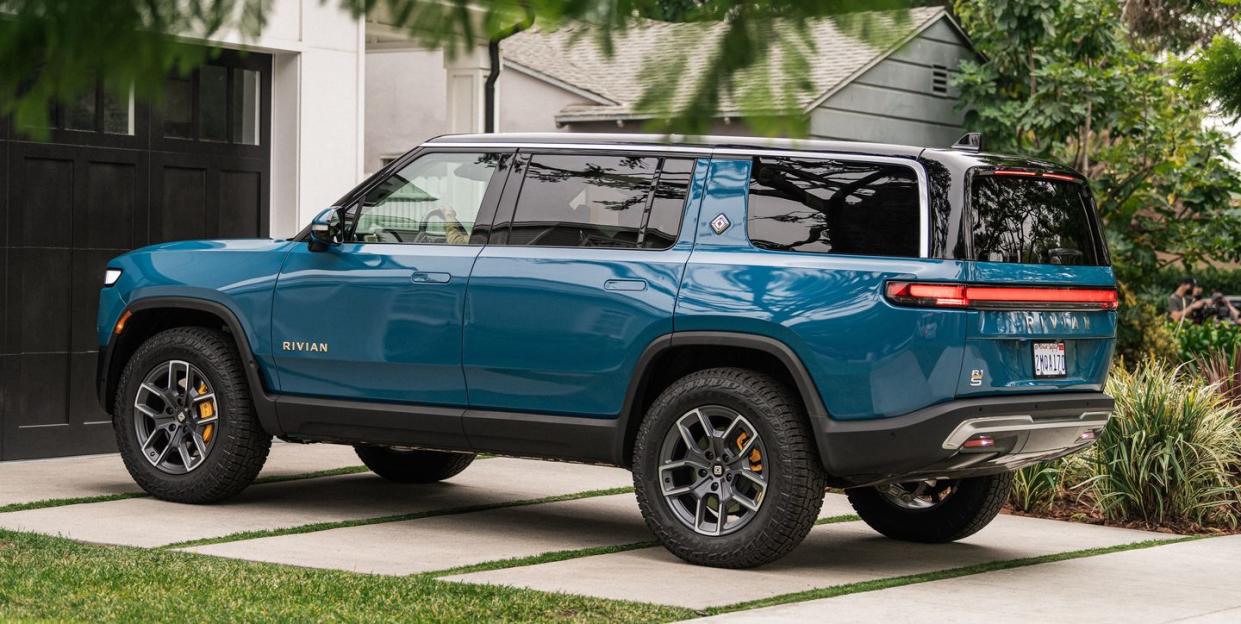
Call me jaded. But since every other new car I test seems to be an EV, that initial rush—of boggling acceleration, silence, and techno-novelty—is fading. Leave it to the Rivian R1S to remind me how special and surprising an EV can be.
Whether Rivian can overcome early stumbles to become an established automaker is a question time will answer. (Rivian Skeptics might at least remind themselves that every successful automaker started small and from scratch; even Tesla wasn't an overnight success). But for people who can afford a big luxury SUV, there’s nothing in showrooms quite like the R1. The bar for circus elephants may be low, but the Rivian makes a case as the market’s sharpest-handling three-row SUV. It’s second in acceleration only to the Tesla Model X Plaid, which costs nearly $50,000 more, and seats seven adults versus the Tesla’s four-plus-two children. If you hurry, there’s still time to cancel your Model X order, because the Rivian is better in nearly every meaningful way, from style, luxury, and interior space to agility and off-road skills.
Like Rivian’s physics-screwing R1T, the 845-horsepower R1S will sprint to 60 mph in 3.1 seconds. A McLaren-esque, cross-linked electrohydraulic anti-roll system helps it handle like a dream, at least dreams that involve 3.5-tons of SUV fun. Move to sand, mud, water or rocks, and the R1S impresses, with precise control from four electric motors and up to 15.0 inches of maximum ground clearance from a firmly sprung air suspension. The big Riv’ also brings more interior and cargo space than a long-wheelbase Range Rover (despite being four inches shorter), and beats the Rover’s estimable performance either on-road or off.
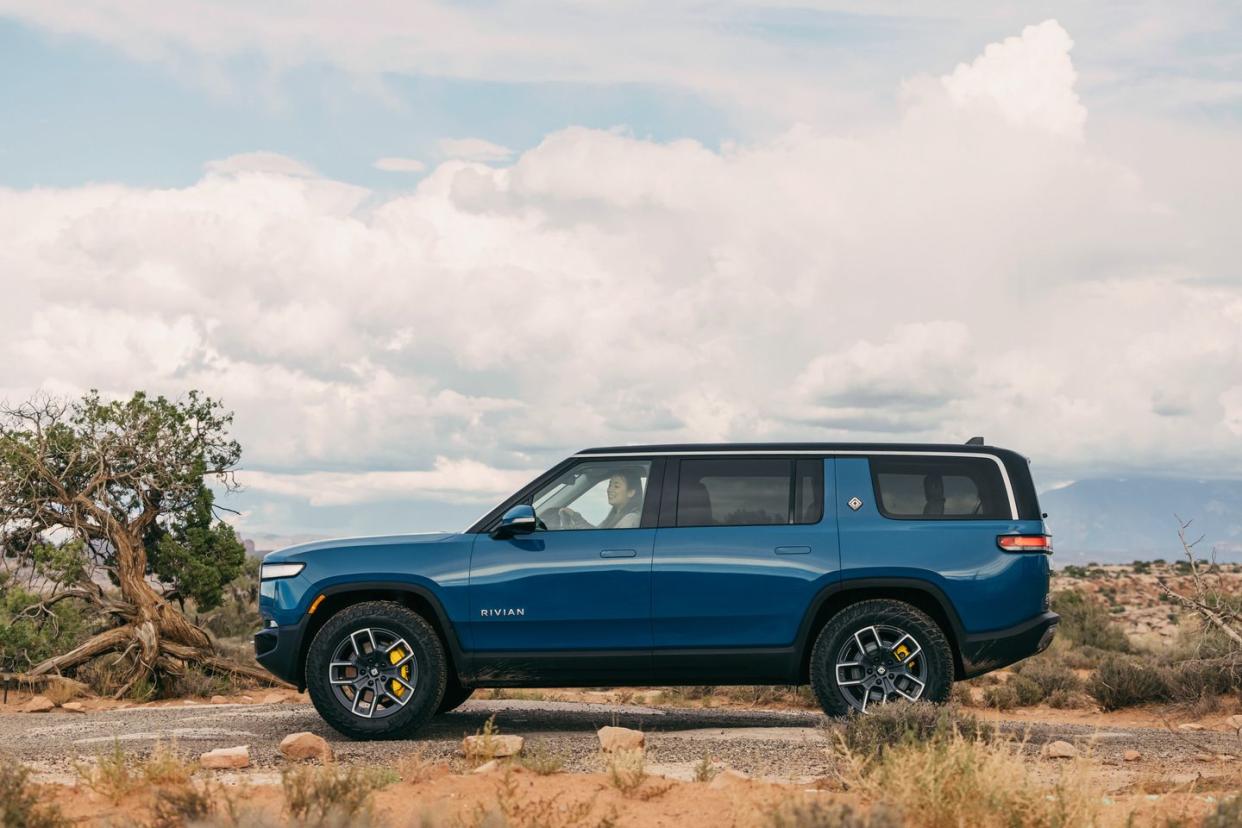
In fact, line ‘em all up—BMW X7, Mercedes GL-Class, Cadillac Escalade, Lincoln Navigator, Jeep Wagoneer—and the Rivian shoots them down like a carnival hustler. Moving to the plug-in side of the garage, only the $106,095 BMW iX M60i feels sharper and more car-like on pavement, in part because it carries about 1,200 fewer pounds than the 7,000-pound Rivian. But that BMW is a smaller two-row SUV that only cares about acing the street-driving test. Even that 532-hp BMW gives up 313 horsepower to the Rivian, and is slower in a straight line, at 3.6 seconds to 60. As for the Mercedes EQS SUV, the Rivian crushes its power, handling, and off-road ability, and carves out more interior and cargo space, including a generous 11 cubic-foot frunk vs. the frunk-free Mercedes. All that for nearly $36,000 less, at $91,500 for an R1S Adventure with Quad Motor propulsion and “Large” 128.9 kWh battery pack. My loaded Adventure model, minus only accessories like a Yakima tent, cost $101,500. That compares with $127,100 for the only remotely comparable Mercedes version, the 536-hp EQS 580 4Matic, before the first option is added.
That R1T brings an EPA-rated 316-mile range, on 21-inch wheels with all-season tires, with mileage dinged slightly by handsome 22-inch wheels with sportier rubber or 20’s with Pirelli Scorpion all-terrains. More-affordable R1S’ with a forthcoming dual-motor, in-house drive unit should deliver more than 600 horsepower, 600 pound-feet of torque, a 4.0-second 0-60 sprint, and roughly 260 miles of range, for $79,500 to start. Rivian has dropped its once-promised, base-model Explore versions. But the company expects a battery-stuffed “Max Pack” model to deliver about 400 miles of class-beating range.
Inside and out, everything from the B-pillar forward is a virtual mirror image of the R1T, but with a broader choice of five interior configurations, such as a bucolic “Forest Edge” with green faux leather. The all-new Range Rover remains the Succession-level superyacht of SUVs. Yet the Rivian still looks contemporary and inviting, with none of the cost-cutting scent that pervades the GMC Hummer EV pickup. My test model’s “Black Mountain” interior set a luxurious, virtuous mood with rich-grained, reclaimed black ash timber, and coppery trim. Handsomely sectioned and patterned seats might win the Eames’ seal of approval. Rivian’s familiar, dual upright displays bring generous screen real estate and mostly intuitive controls, albeit with overly precious steering-wheel thumbwheels to adjust the wheel, vents, and exterior mirrors. (To Rivian’s defense, once those features are set to your liking, how often do you really need to screw with them)? A wireless charging pad in the clamshell-style center console fits two phones, side-by-side. My only major interior gripe is the desultory steering wheel itself: Its passenger-car style and grip reminded me of the Ford Bronco’s parts-bin till, a lost opportunity to make a striking or adventurous statement.
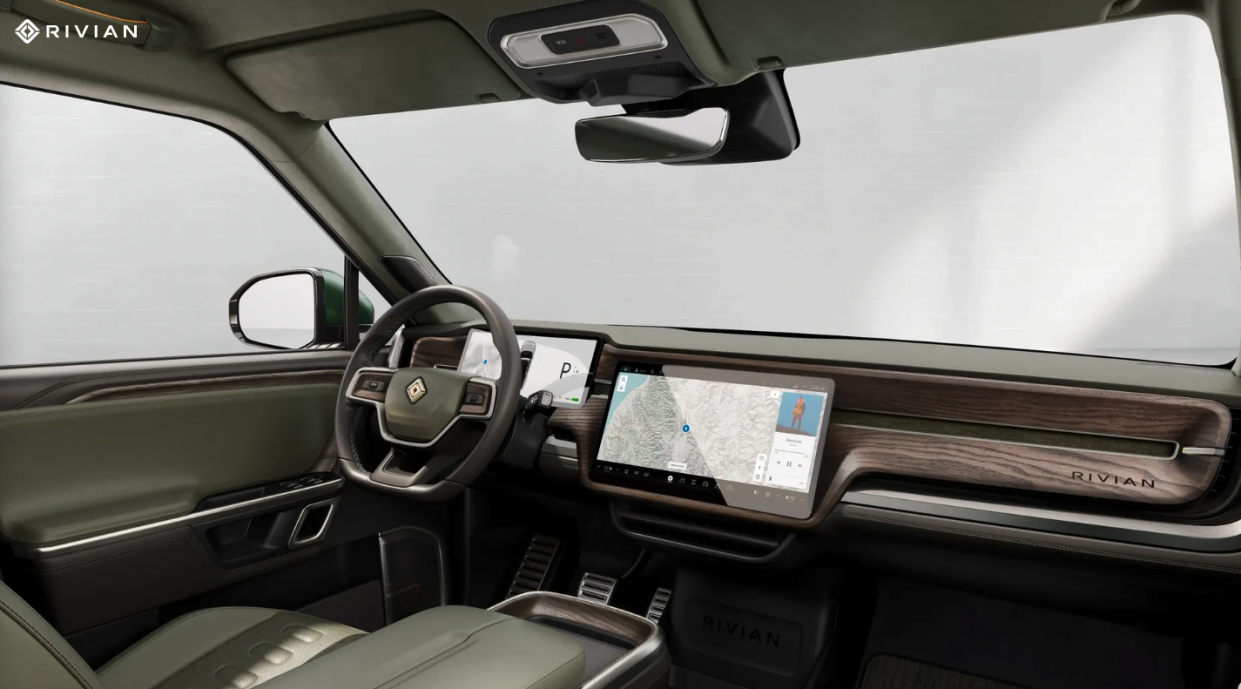
Swiveling that wheel, and my head, in a Michigan parking lot underscored why—for a likely majority of buyers—the R1S will be the most desirable Rivian. The R1S is about 17 inches shorter than the pickup, on a 14.7-inch-shorter wheelbase. That means a much-shorter turning circle on-road or off, and better breakover-and-departure angles. (Towing capacity drops from 11,000 pounds to 7,700, but c’mon). And a glance rearward reveals a passenger-and-cargo auditorium that defies the 200.8-inch long exterior footprint. Second-row legroom is merely average among three-row haulers of this size. But the third row can absolutely handle six-foot-plus adults on shorter trips, albeit with a familiar low cushion and slightly knees-up position. A one-button affair pivots and slides the second row, for only mildly tricky ingress-and-egress. Flip-up armrests in the third row house cubby storage and two of the eight onboard USB-C ports.
A surprising 17.6 cubic feet of storage behind the third row dwarfs the 6.8 cubes of the Mercedes EQS. (As with the Benz, that third row is manually operated only). The hatch’s standard air compressor underlines Rivian’s innovative ethos, filling tires or gear to a pre-chosen level (within 0.1 PSI) by hitting a “play” button. The Rover-style, split-folding tailgate can support 1,000 pounds worth of chili-loving tailgaters. Folding the second row, split 40/20/40 to fit long gear down the center, affords about 47 cubic feet. A total of 88.2 cubic feet with all seats folded compares with about 78 cubes for the EQS or long-wheelbase Rover. The most direct analog for spaciousness may be Hyundai’s Shamu-size Palisades, a finely packaged SUV by any measure. The Rivian's two-part divided frunk brings total capacity up to 100 cubes, good for just about any Home Depot run.
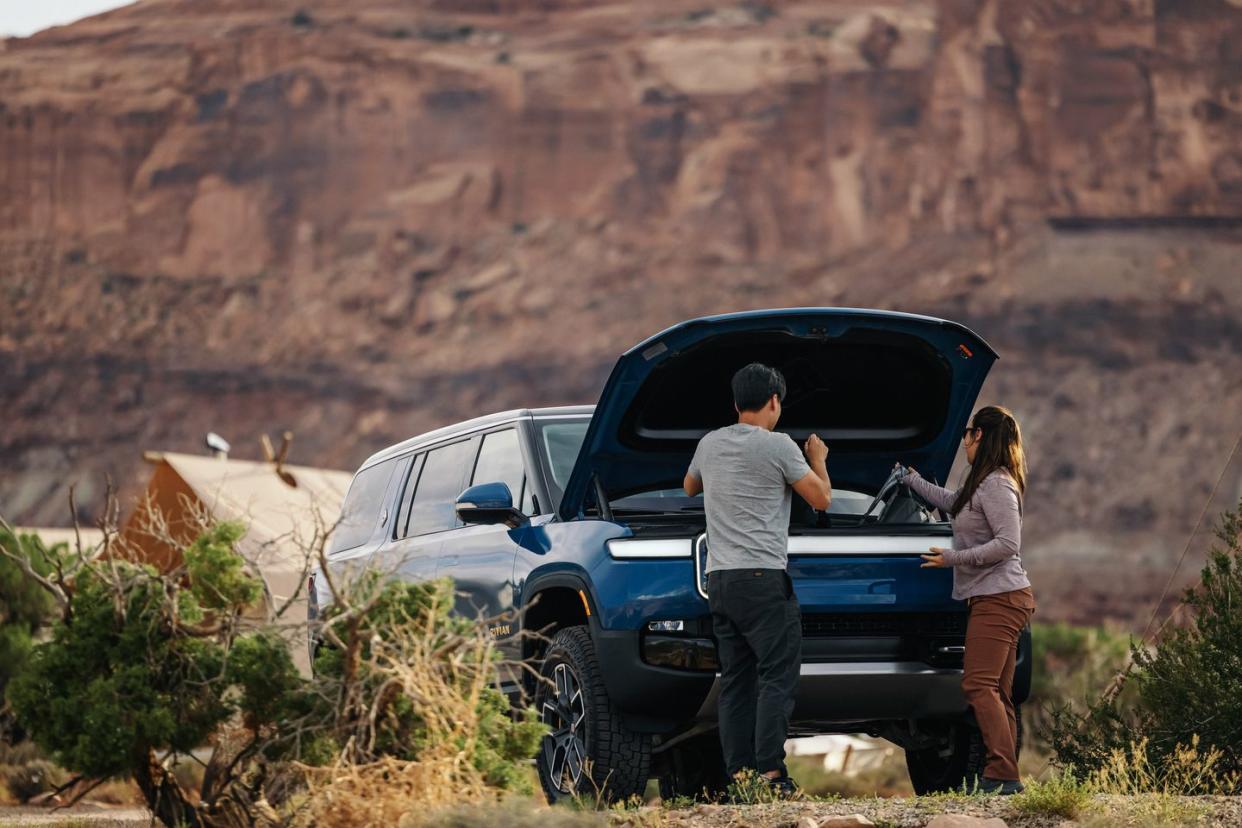
Would-be buyers or backyard Bourdains can shed a tear for the R1T’s Gear Tunnel and Camp Kitchen, obviously unavailable here. But American families will brighten considerably at the R1S’s superior passenger-and-cargo mix. There’s more roof space for tool-free storage crossbars and adventure gear, and three mounting points versus the R1T’s two. Kenneth Tsang, Rivian’s manager of special projects engineering, says the R1T “needed a pitch” through ingenious features like the Camp Kitchen.
“An electric pickup is still weird to some people, not immediately appealing,” Tsang says. “A nice 3-row electric SUV sells itself.”
The looks can only help: The R1S clearly presents as an EV, perfect for stopping neighbors in their lawnmowing tracks. Yet the R1S looks richer and more imposing than the far-longer pickup, with ultra-short overhangs, a polished silhouette, and a chrome-tinged floating roof. It’s so Rover-inspired that Rivian might kick in royalties. (As they say, if you’re going to steal…) Not everyone loves Rivian’s quizzical, Iron Giant face and lustrous eyeballs, but it works for me.

Like its pick-em-up sibling, the R1S presses advantages and ditches competitors with every mad squeeze of the throttle, its sensitive quad motors spinning and vectoring individual wheels with 908 pound-feet of torque. Aside from 3-second bursts to freeway speed, the Rivian can cover a quarter-mile in roughly 11.5 seconds. You know, just a few ticks behind a Corvette C8, and much faster than a C7 Grand Sport. Truth in advertising comes with a “Stiff” suspension mode that noticeably firms the ride and tautens the body. On wooded, no-shoulder twisties north of Ann Arbor, the Rivian carved more faithfully than a pilgrim at the First Thanksgiving. (Fine, Philbrick, don’t get all literal on me).
Switched to Conserve mode, which sidelines rear drive to power front wheels alone, the R1S still accelerates faster than many big SUVs; I’d peg 0-60 mph at about six seconds. During an unexpected sleet attack, the Rivian finally lost traction a bit under irresponsibly hard throttle, but still impressive for an SUV applying roughly 420 horsepower through front wheels alone.
At a standstill, I sampled a mild consolation for Camp Kitchen. A clever Camp Mode sensed body tilt in four directions and adjusted (in this case) front-right and left-rear springs to create a flat interior. That makes for easier ingress/egress, more restful sleep, or, when you’re really roughing it, a spill-free experience drinking your Camp Martini. A newly created Sand Mode, informed by Rebelle Rally experience, softens the suspension and coaxes wheelspin by relaxing traction control, helping drivers keep those wheels churnin’ in dunes and desert.
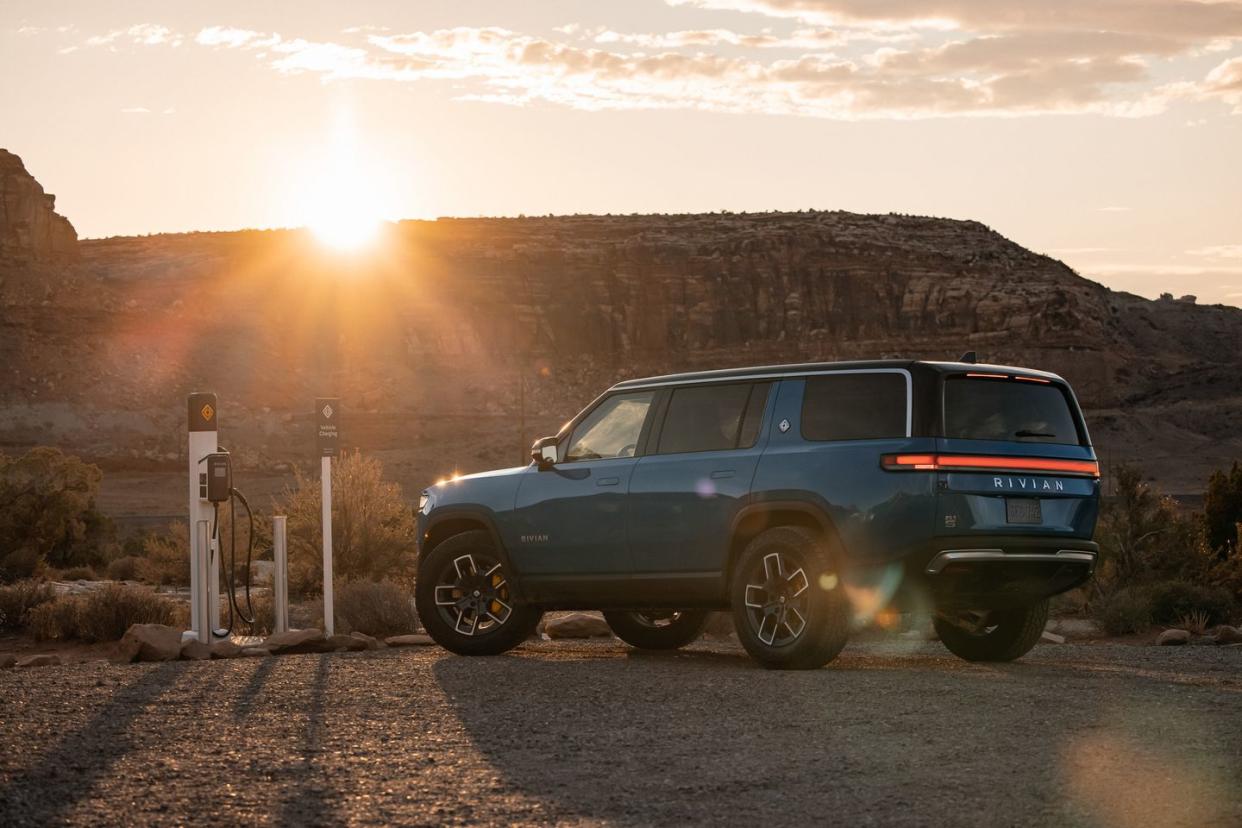
Another Rivian update lets models absorb DC current at around 200 kilowatts, for a 10-to-80-percent charge in just over 30 minutes. With Tesla smoking all comers in the nationwide network battle, Rivian is at least playing catch-up by building a network that envisions roughly 3,500 DC fast chargers at 600 sites. That plan calls for more than 10,000 Level 2 “Waypoint” chargers—near restaurants, hotels, parks, or campgrounds—to add up to 25 miles per hour at an 11.5-kW rate.
Rivian and its young CEO RJ Scaringe won’t be taking a camping vacation anytime soon. Just in recent weeks, Rivian’s long and winding road to revenue and respectability has involved a recall of most of 13,000 vehicles it has built, and the elimination of the R1T’s troubled power-tonneau cover as an option. In March, grinding supply-chain delays and other issues led Rivian to halve its estimate of 2022 production from 50,000 to 25,000 units. The company said it built 4401 R1Ts and R1Ss in Normal, Ill. for the second quarter, and delivered 4467 vehicles to customers. But long backlogs remain, and jittery investors have pushed Rivian’s stock price down by two-thirds this year.
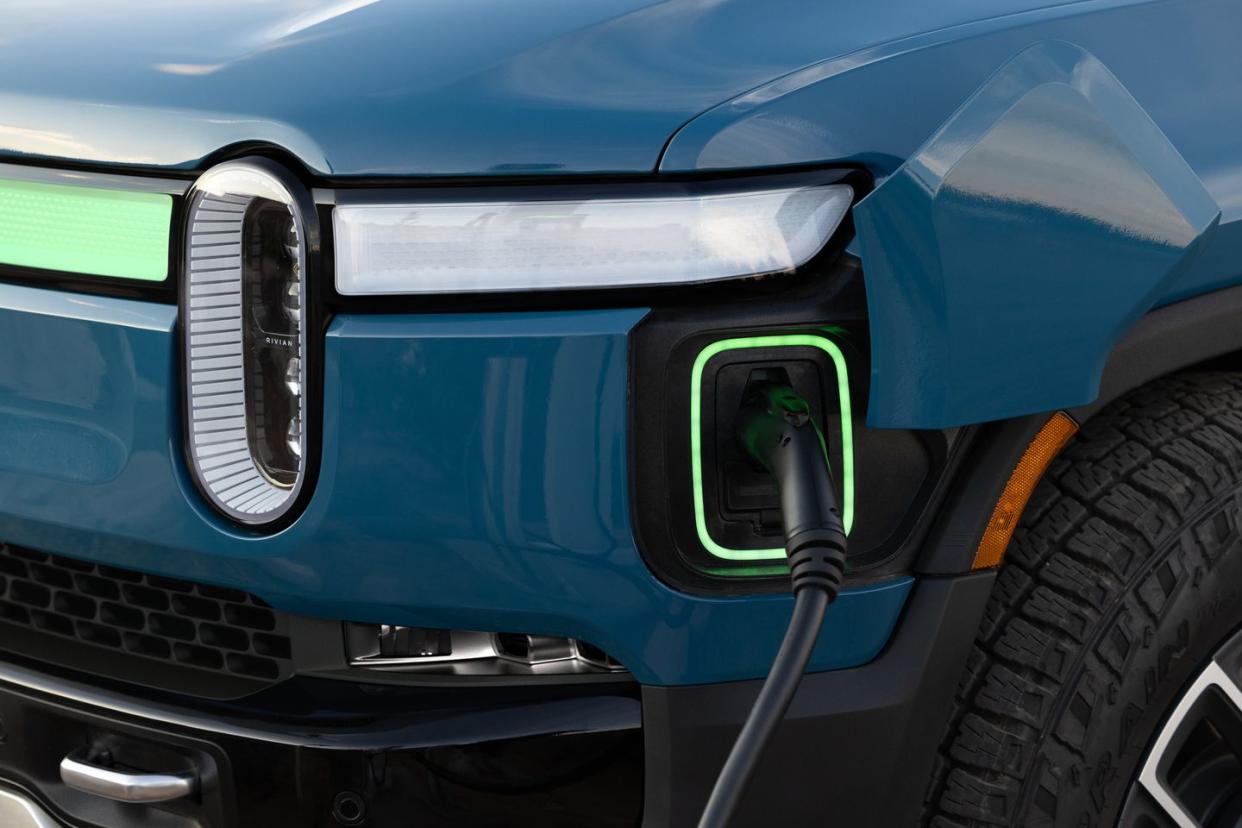
To anyone versed in early Tesla history, when Musk and Co. had to create the world’s first viable EV company, cars, and tech from tabula rasa—in the face of withering skepticism, opprobrium, and powerful enemies from car dealers to oil companies—Rivian’s teething problems seem almost mild by comparison. Yet Tesla found first-mover advantage, changed the game with its Supercharger network, and has ridden both to dominate the global EV market.
Here in 2022, with many global automakers going all-in on EVs, Rivian has lost the advantage of surprise and exclusivity. All it can do is deliver compelling vehicles—quality and company trust being part of “compelling”—in enough numbers to steadily win people over and get the Rivian name on lips and shopping lists. The R1S holds up its end of the bargain, a brilliant example of what EV design, tech, and performance can be. The rest is up to Rivian.
You Might Also Like
